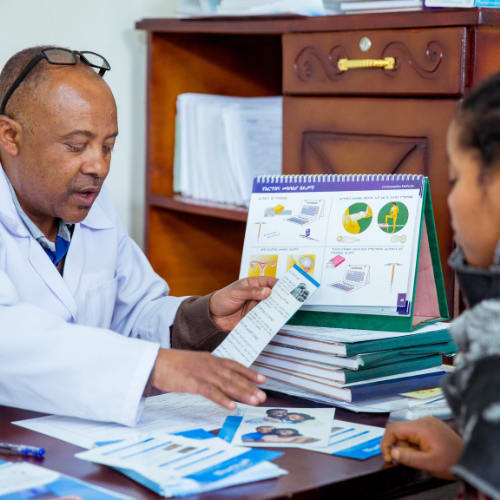Leveraging Social Accountability to Include Family Planning in Country-Level Universal Health Coverage: Four Lessons Learned from PAI’s UHC Engage Project

Over the past two years, under our UHC Engage project, PAI and civil society partners in sub-Saharan Africa and Asia have focused on the opportunities to advance sexual and reproductive health and rights, including family planning, as part of universal health coverage reform. The challenge is that universal health care is multifaceted and country-specific in nature. Decoding the policy and financing reform environment for each country is key to illuminating the openings that exist for civil society to engage policymakers to increase access to sexual and reproductive health services for everyone, especially women and girls.
The details of emerging policies at the country level are not widely available at the global and regional levels and the country briefs in our Decoding Country-Level UHC Financing Policy series fill this critical knowledge gap.
In 2018, India’s government launched Ayushman Bharat, the parent program of its Health and Wellness Centers and the world’s largest public health insurance scheme, Pradhan Mantri Jan Arogya Yojana. One of the largest challenges of this process is that many Health and Wellness Centers are not yet operational, which has exacerbated family planning access gaps in the public sector.
The goal of universal health coverage (UHC) is inspiring landmark political and systemic change all over the world to guarantee access to the quality services people need — spanning preventive through palliative care — and financial protection to ensure they are not pushed into poverty by realizing their right to health care. However, the details of emerging policies at the country level are not widely available at the global and regional levels. Through the UHC Engage project, PAI and partners collaborated to develop a series of publications demystifying country-specific UHC financing policies to illustrate family planning (FP) advocacy opportunities and inform the international dialogue. As each country is in a different stage of UHC financing reform, these briefs deconstruct UHC policy processes in real time, illuminate multifaceted examples for advancing FP in UHC-oriented policies and offer insights across multiple contexts for sexual and reproductive health and rights advocates to strengthen global action.
In 2018, India’s government launched Ayushman Bharat, the parent program of its Health and Wellness Centers (HWCs) and the world’s largest public health insurance scheme, Pradhan Mantri Jan Arogya Yojana (PM-JAY). Ayushman Bharat is meant to serve as the country’s health financing catalyst toward UHC, but individual states must determine their own execution strategies. One of the largest challenges of this process is that many HWCs are not yet operational, which has exacerbated FP access gaps in the public sector. To track and dismantle these implementation barriers, the civil society organization Sahayog Society for Participatory Rural Development (SAHAYOG) has been working with key partners and government officials ranging from the community level to the national level.
With nearly one-fifth of the world’s population and a decentralized governance structure, India faces unique challenges meeting its Family Planning 2020 (FP2020) commitments. According to its 2017 FP2020 commitment, the national government intends to increase the modern contraceptive prevalence rate (mCPR) and satisfy demand by strengthening access, choice and quality of FP services nationwide. Over the past several years, the government has prioritized expanding contraceptive method choice and the range of FP services at all levels of care, strengthening the FP supply chain, increasing the private sector’s role in FP service provision and increasing domestic resources for FP. Given India’s decentralized government, progress varies across the 28 states and eight union territories. For example, in the state of Uttar Pradesh, there is markedly lower FP coverage of modern contraceptive methods among currently married women compared to national-level figures: 31.7% and 52.6%, respectively, indicating a need for major improvements in access to these methods. Despite the variance in FP demand and access across the country, contraceptive method mix is heavily skewed toward female sterilization at 75.3%, followed by condoms at 11.7%, according to FP2020. Female sterilization has declined relative to national trends, but it continues to be the primary modern method used in Uttar Pradesh.
As of 2017, the national government financed 90% of FP commodities from domestic resources. Since the announcement of the Ayushman Bharat reform, India’s government has been covering the cost of FP commodities and services through HWCs — the new primary health care network — so that sexual and reproductive health (SRH) care is free in all public facilities. Alongside this broader government-financed FP coverage effort, disparate FP voucher programs that are primarily financed by donors will continue to be offered.
One of the government’s key strategies to achieve UHC is to increase domestic budgets and development assistance for health. Its 2017 National Health Policy presented the vision for a first-of-its-kind UHC scheme, which aims to provide high-quality, affordable health care without financial hardship, especially for groups at higher risk of poor health due to social, economic, political and environmental barriers. India’s government has advertised that once this UHC scheme is complete, Ayushman Bharat will be the world’s largest public health care program.
Currently, though, the government’s spending on health is very low — in 2017, this amounted to just 27% compared with 60% paid out of pocket by the Indian people. India has one of the highest rates of out-of-pocket spending on health globally, which places an undue burden on individuals and families. Seventy-two percent of out-of-pocket health spending is on primary health care, and catastrophic out-of-pocket costs for health services push 39 million people, or 7% of the population, below the poverty threshold every year.
We are fighting back against the onslaught of harmful policies that discard reproductive rights.
Stay informed about the issues impacting sexual and reproductive health and rights.
